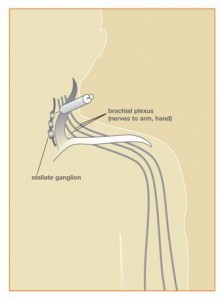Formerly Known as Reflex Sympathetic Dystrophy (RSD)
What is Complex Regional Pain Syndrome (CRPS)?
Complex regional pain syndrome (CRPS) is a pain condition that is constant over a long period of time that is believed to be the result of dysfunction in the central or peripheral nervous systems. CRPS is characterized by pain, swelling or stiffness in the affected hand or extremity. The pain may be out of proportion to the injury that triggered it. CRPS is usually associated with an injury, which can sometimes be as minor as a paper cut or small bruise. It causes the nervous system to misfire and send frequent or constant signals to the brain that are interpreted as painful. The nervous system becomes overactive, causing intense burning or aching pain, along with swelling and changes in skin color and moisture.
Who gets CRPS?
The causes of CRPS are not known. CRPS can begin after a minor injury, such as a sprain or small cut, or after major trauma or surgery. Injury to a nerve may also provoke its onset. It is most common among individuals between 25 and 55 years of age, though anyone of any age can be affected. CRPS is three times more likely to occur in women than men. An estimated 60,000 Americans are affected by CRPS.1,2
Signs and Symptoms of CRPS
The key symptom of CRPS is continuous, intense pain out of proportion to the severity of the injury (if an injury has occurred). CRPS most often affects one of the extremities and is also often associated with the following symptoms:
- “Burning” pain
- Increased skin sensitivity
- Changes in skin temperature: warmer or cooler compared to the opposite extremity
- Changes in skin color: often blotchy, purple, pale, or red
- Changes in skin texture: shiny and thin, and sometimes excessively sweaty
- Changes in nail and hair growth patterns
- Swelling and stiffness in affected joints
- Motor disability, with decreased ability to move the affected body part
The pain may spread to include the entire arm or leg, even though the initiating injury might have been only to a finger or toe. Pain can sometimes even travel to the opposite extremity. It may be heightened by emotional stress.
Diagnosis of CRPS
There is no single test to confirm a diagnosis of CRPS. The diagnosis is primarily through observation of signs and symptoms. Patients must be examined by a qualified physician who does a thorough history and physical examination. X-rays, MRI, EMG/NCV, bone scans, thermography, or pain imaging where available may be helpful. Consultation with other specialists may be needed, and a pain clinic is often recommended.
Treatment of CRPS
The earlier the diagnosis of CRPS is made and treatment started, the better the chance for recovery. Treatment is varied and depends on both the severity of the symptoms and the duration of the problem. Aerobic conditioning, relief of sleep disorders, and treatment of psychological problems can be helpful for treatment. Some patients may have a chronic physical problem, such as a compressed or entrapped nerve, that needs to be addressed. Since there is no simple cure for CRPS, treatment is intended to relieve painful symptoms so that patients can resume their normal lives as well as optimize use of the hand or extremity.
Any of the following may be employed to treat CRPS, often in combination:
- Occupational/Physical Therapy. An increasing exercise program to help with motion may help preserve or restore mobility and function to the affected hand. Overall aerobic conditioning is very important to improve coping ability, sleep, and pain control.
Psychotherapy. CRPS can have profound psychological effects on patients and their families. Many with CRPS have depression, anxiety, or post-traumatic stress disorder. A psychologist or psychiatrist may be able to improve coping ability and motivation as well as detect and address any substance dependency issues.
- Nerve Blocks. Many patients experience significant relief from nerve blocks, in which local anesthetic is injected to numb nerves. By relieving pain, blocks can enable more effective therapy, improve mood, and improve level of activity. Stellate ganglion blocks may be used to numb the stellate ganglion, which is a cluster of sympathetic nerves at the base of the neck, in an effort to reduce the over-activity of the sympathetic nerves seen in CRPS (see Figure 1).
- Medications. Many different drugs are used to treat CRPS and associated conditions, such as sleep disorders, depression, and anxiety. Medications may include topical analgesics, anti-seizure drugs, antidepressants, corticosteroids, muscle relaxants, opioids, and sleeping medications.
- Surgery. If the CRPS is from a compressed nerve, such as with carpal tunnel syndrome, then surgery to release pressure on the nerve may be needed (e.g., carpal tunnel release). Rarely, an operation known as sympathectomy is used to divide the sympathetic nerves in patients who are helped by nerve blocks, and its use is controversial.
 Figure 1
Figure 1
Other options include spinal cord stimulation and intrathecal drug pumps, in which pain medications are injected continuously into the space around the spinal cord. Deep brain stimulation and Electrotherapy (ECT) have also been used, but new therapies continue to emerge.
Prognosis
Each patient with CRPS responds differently to treatment. Spontaneous improvement occurs in some persons. Others may have crippling, irreversible changes in spite of appropriate treatment. Most physicians believe that early treatment is helpful to limit the disability from CRPS. More research is needed to understand the causes, the development of the disease, and how treatment can alter its course.
Download the Complex Regional Pain Syndrome PDF
